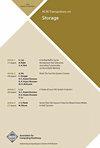A Scalable Wear Leveling Technique for Phase Change Memory
IF 2.6
3区 计算机科学
Q3 COMPUTER SCIENCE, HARDWARE & ARCHITECTURE
引用次数: 0
Abstract
Phase Change Memory (PCM), one of the recently proposed non-volatile memory technologies, has been suffering from low write endurance. For example, a single layer PCM cell could only be written approximately 10 8 times. This limits the lifetime of a PCM-based memory to a few days rather than years when memory intensive applications are running. Wear leveling techniques have been proposed to improve the write endurance of a PCM. Among those techniques, the region based start-gap (RBSG) scheme is widely cited as achieving the highest lifetime. Based on our experiments, RBSG can achieve 97% of the ideal lifetime but only for relatively small memory sizes (e.g. 8GB-32GB). As the memory size goes up, RBSG becomes less effective and its expected percentage of the ideal lifetime reduces to less than 57% for a 2TB PCM. In this paper, we propose a table-based wear leveling scheme called block grouping to enhance the write endurance of a PCM with a negligible overhead. Our research results show that with a proper configuration and adoption of partial writes (writing back only 64B subblocks instead of a whole row to the PCM arrays) and internal row shift (shifting the subblocks in a row periodically so no subblock in a row will be written repeatedly), the proposed block grouping scheme could achieve 95% of the ideal lifetime on average for the Rodinia, NPB, and SPEC benchmarks with less than 1.74% performance overhead and up to 0.18% hardware overhead. Moreover, our scheme is scalable and achieves the same percentage of ideal lifetime for PCM of size from 8GB to 2TB. We also show that the proposed scheme can better tolerate memory write attacks than WoLFRAM (Wear Leveling and Fault Tolerance for Resistive Memories) and RBSG for a PCM of size 32GB or higher. Finally, we integrate an error-correcting pointer technique into our proposed block grouping scheme to make the PCM fault tolerant against hard errors.一种可扩展的相变存储器磨损均衡技术
相变存储器(PCM)是近年来提出的一种非易失性存储技术,其写入持久时间较低。例如,单层PCM单元只能被写入大约108次。当运行内存密集型应用程序时,这将基于pcm的内存的寿命限制在几天,而不是几年。为了提高PCM的写入耐久性,提出了磨损调平技术。在这些技术中,基于区域的启动间隙(RBSG)方案被广泛引用为具有最高的生命周期。根据我们的实验,RBSG可以达到理想寿命的97%,但仅适用于相对较小的内存大小(例如8GB-32GB)。随着内存大小的增加,RBSG变得不那么有效,对于2TB PCM,其理想寿命的预期百分比减少到不到57%。在本文中,我们提出了一种基于表的磨损均衡方案,称为块分组,以微不足道的开销提高PCM的写入持久性。与适当的配置和我们的研究结果表明,采用部分写(写只有64 b子块而不是整个行PCM数组)和内部行转移(转移子块连续定期所以没有子块连续反复写),提出了块分组方案能达到95%的理想一生平均Rodinia, NPB和SPEC基准性能开销不到1.74%和0.18%的硬件开销。此外,我们的方案是可扩展的,并且对于大小从8GB到2TB的PCM实现了相同的理想寿命百分比。我们还表明,对于大小为32GB或更高的PCM,所提出的方案比WoLFRAM(耐磨均衡和容错电阻存储器)和RBSG更好地耐受内存写攻击。最后,我们将纠错指针技术集成到我们提出的块分组方案中,使PCM对硬错误具有容错性。
本文章由计算机程序翻译,如有差异,请以英文原文为准。
求助全文
约1分钟内获得全文
求助全文
来源期刊

ACM Transactions on Storage
COMPUTER SCIENCE, HARDWARE & ARCHITECTURE-COMPUTER SCIENCE, SOFTWARE ENGINEERING
CiteScore
4.20
自引率
5.90%
发文量
33
审稿时长
>12 weeks
期刊介绍:
The ACM Transactions on Storage (TOS) is a new journal with an intent to publish original archival papers in the area of storage and closely related disciplines. Articles that appear in TOS will tend either to present new techniques and concepts or to report novel experiences and experiments with practical systems. Storage is a broad and multidisciplinary area that comprises of network protocols, resource management, data backup, replication, recovery, devices, security, and theory of data coding, densities, and low-power. Potential synergies among these fields are expected to open up new research directions.
 求助内容:
求助内容: 应助结果提醒方式:
应助结果提醒方式:


